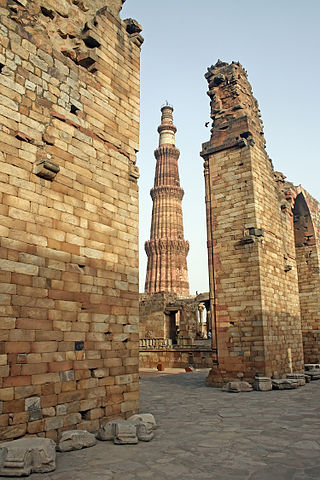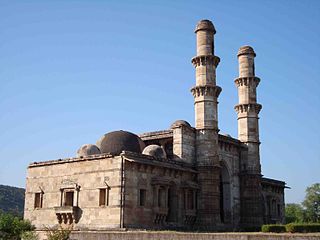
The Qutb Minar complex are monuments and buildings from the Delhi Sultanate at Mehrauli in Delhi, India. Construction of the Qutub Minar "victory tower" in the complex, named after the religious figure Sufi Saint Khwaja Qutbuddin Bakhtiar Kaki, was begun by Qutb-ud-din Aibak, who later became the first Sultan of Delhi of the Mamluk dynasty. It was continued by his successor Iltutmish, and finally completed much later by Firoz Shah Tughlaq, a Sultan of Delhi from the Tughlaq dynasty (1320–1412) in 1368 AD. The Qubbat-ul-Islam Mosque, later corrupted into Quwwat-ul Islam, stands next to the Qutb Minar.

Burhanpur is a historical city in the Indian state of Madhya Pradesh. It is the administrative seat of Burhanpur District. It is situated on the north bank of the Tapti River and 512 kilometres (318 mi) northeast of city of Mumbai, 340 kilometres (211 mi) southwest of the state's capital city of Bhopal. The city is a Municipal Corporation.

Indo-Islamic architecture is the architecture of the Indian subcontinent produced by and for Islamic patrons and purposes. Despite an initial Arab presence in Sindh, the development of Indo-Islamic architecture began in earnest with the establishment of Delhi as the capital of the Ghurid dynasty in 1193. Succeeding the Ghurids was the Delhi Sultanate, a series of Central Asian dynasties that consolidated much of North India, and later the Mughal Empire by the 15th century. Both of these dynasties introduced Islamic architecture and art styles from West Asia into the Indian subcontinent.

Champaner-Pavagadh Archaeological Park, a UNESCO World Heritage Site, is located in Panchmahal district in Gujarat, India. It is located around the historical city of Champaner, a city which was founded by Vanraj Chavda, the most prominent king of the Chavda Dynasty, in the eighth century. He named it after the name of his friend and general Champa, also known later as Champaraj. The heritage site is studded with forts with bastions starting from the hills of Pavagadh, and extending into the city of Champaner. The park's landscape includes archaeological, historic and living cultural heritage monuments such as chalcolithic sites, a hill fortress of an early Hindu capital, and remains of the 16th-century capital of the state of Gujarat. There are palaces, entrance gates and arches, mosques, tombs and temples, residential complexes, agricultural structures and water installations such as stepwells and tanks, dating from the eighth to the 14th centuries. The Kalika Mata Temple, located on top of the 800 metres (2,600 ft) high Pavagadh Hill, is an important Hindu shrine in the region, attracting large numbers of pilgrims throughout the year.

The Great Mosque of Gaza, also known as the Great Omari Mosque is the largest and oldest mosque in the Gaza Strip, located in Gaza's old city, in the State of Palestine.

The Jama Mosque is a 17th-century congregational mosque located in the historic core of Agra, Uttar Pradesh. It was built by Jahanara Begum, the eldest daughter of Mughal Emperor Shah Jahan, during the latter's reign. It is the principal mosque in the city of Agra, and lies close to Agra Fort.

Jama Masjid or Jama Mosque or Jami Masjid or Badi Masjid, one of the largest Mosques in India, is a 15th-century mosque built by Hussain Shah Sharqi of the Jaunpur Sultanate in Jaunpur, Uttar Pradesh, India. It is one of the chief tourist attractions in Jaunpur. The mosque is 2.2 km north-northeast of Jaunpur, 7.3 km northwest of Zafarābād, 16.8 km north-northeast of Mariāhū, 26.3 km west-northwest of Kirākat. It is 1 km from the Atala mosque.

Lal Darwaza Mosque of Jaunpur, was built in 1447 by Queen Rajye Bibi and dedicated to Sayyid Ali Dawood Kutubbudin a saint.

Jama Masjid, also known as Jumah Mosque or Jami' Masjid, is a mosque in Ahmedabad, and was built in 1424 during the reign of Ahmad Shah I. The inscription on the central mihrab commemorates the inauguration of the mosque on the 1st Safar A.H. 827 or January 4, 1424 A.D. by Sultan Ahmad Shah I. The mosque lies in the old walled city, and it is situated outside Bhadra Fort area. The old walled city is divided into separate quarters or pols, and the Jami' Masjid is found on the Gandhi Road. Along the south side of the road, the mosque is a short distance beyond the Teen Darwaza or Tripolia Gate.

Kevada Mosque is a mosque in Champaner, Gujarat state, western India. It is part of the Champaner-Pavagadh Archaeological Park, a UNESCO World Heritage Site. The mosque has minarets, globe-like domes, and narrow stairs. According to Ruggles (2008), nature was integrated into the Kevada mosque's architecture in a way that was unusual elsewhere in the Islamic world.

Bawaman Mosque is a mosque in Champaner, western India. It is situated on the western side of one of the ancient city's fort gates, within the Champaner-Pavagadh Archaeological Park of Gujarat.

Nagina Mosque is a mosque in Champaner, Gujarat, India. It was built during the time of Mahmud Begada, in the 15th century, as were several other masjids, such as the Kevada, Bawaman, Ek Minar, Jama, Khajuri, and Shahar Ki. It has minarets, globe-like domes, and narrow stairs. It is part of the Champaner-Pavagadh Archaeological Park, a UNESCO World Heritage Site.

There are eleven different types of buildings at the UNESCO-protected Champaner-Pavagadh Archaeological Park in Gujarat, India, including mosques, temples, granaries, tombs, wells, walls, and terraces. The monuments are situated at the foot of and around the Pavagadh Hill. The Baroda Heritage Trust lists 114 monuments in the area, of which only 39 are maintained by the Archaeological Survey of India, due to limited funding. The Forest Department owns 94% of the land here, while the temple trusts and other sectarian establishments provide facilities for boarding and lodging to pilgrims and tourists. On the southern side near the foot of the hill some dilapidated houses and the foundations of Jain temples can also be seen.

Persian Inscriptions on Indian Monuments is a book written in Persian by Dr Ali Asghar Hekmat E Shirazi and published in 1956 and 1958 and 2013. New edition contains the Persian texts of more than 200 epigraphical inscriptions found on historical monuments in India, many of which are currently listed as national heritage sites or registered as UNESCO world heritage, published in Persian; an English edition is also being printed.

Achut Bibi's Mosque and Tomb, also known as Shahi Masjid locally, is a medieval mosque and tomb complex on the bank of Sabarmati river in Dudheshwar, Ahmedabad, India.

Jama Masjid is a historic mosque in Mandu in the Central Indian state of Madhya Pradesh. Built in Mughal style of architecture, the mosque has been believed to have been built during the reign of Hoshang Shah and completed during the reign of Mahmud Khilji in 1454.
The Architecture of Gujarat consists of architecture in the Indian state of Gujarat.

Jumma Masjid or Jama Masjid is a mosque in Uparkot Fort in Junagadh, Gujarat, India. The mosque was built in 15th century by converting a temple or a palace now identified as Ranakdevi Mahal by local people. There is a controversy surrounding the identification of the structure.

The Tomb of Shah Nawaz Khan is a 17th-century Mughal tomb in Burhanpur, in the Indian state of Madhya Pradesh. It is listed as a monument of national importance. The tomb is also nicknamed the "Black Taj Mahal" owing to the black stone used in its construction.

Jama Masjid is a mosque in Burhanpur, in the Indian state of Madhya Pradesh. It is listed as a monument of national importance.



















